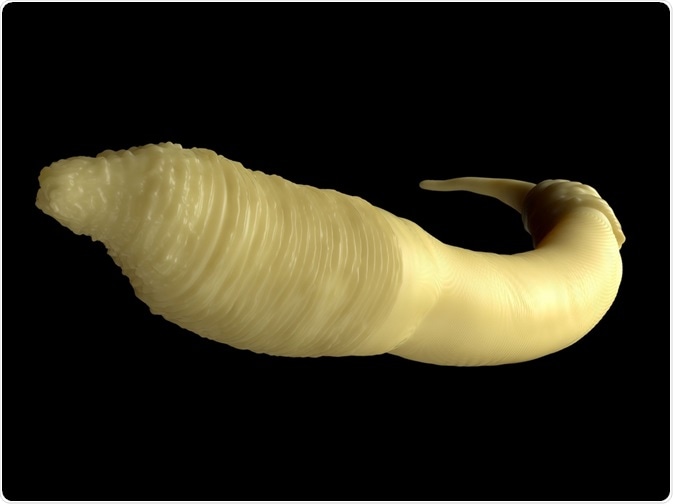The nematode worm, Caenorhabditis elegans, has long been used as a model organism for human health and development. With many genes having functional counterparts in humans, what can lifespan-increasing mutations in C. elegans reveal about human aging?
Since the early 1960s, genomic studies have harnessed the potential of multicellular model organisms to gain a deeper understanding of human genetics. In recent decades, the C. elegans model system has been utilized to study aging as well as age-related disease and mechanisms of longevity.

Image Credit: Peddalanka Ramesh Babu/Shutterstock.com
Why the worm model system?
Developing with an almost unusual degree of regularity, the short life cycle and simple body plan of C. elegans make them ideal candidates for genetic studies. While this species shows no physical similarities to humans, the conservation of biological processes have allowed for these models to provide critical insights into development.
In the early 1970s, Brenner used the potential of C. elegans to reveal information about the development of neural networks in humans. His work confounded C. elegans as a model organism and by 1998, the C. elegans was the first multicellular organism to have its complete genome sequenced and published.
Almost half a century after Brenner's work, researchers have engineered worms with life spans five times greater than usual. Studies have found mutations in cell apoptosis genes of C. elegans that could harbor the key to counteracting the effects on human aging. Highly conserved insulin/insulin-like signaling (IIS) and target of rapamycin (TOR) pathways play an important role in aging across species. By inhibiting these pathways individually, researchers have been able to increase the lifespan of C. elegans by 100% and 30%.
The influence of the IIS pathway on worm lifespan
The C. elegans IIS pathway has three key genes, daf-2, age-1, and daf-16; encoding for homologs of mammalian insulin/IGF-I receptor (INSR), phosphoinositide 3 kinase (PI3K) p110 subunit, and forkhead box O (FOXO) transcription factor, respectively. By introducing mutations in daf-2, the activity of IIS pathways is reduced. This leads to the phosphorylation and translocation of DAF-16 into the nucleus to bind and initiate the expression of target genes.
Reduced IIS, alongside DAF-16 activity, promotes SKN-1. This ortholog of human Nrf transcription factors works in parallel with DAF-16 to increase the expression of extracellular matrix genes and promote resistance to oxidative stressors. However, recent studies suggest SKN-1 may have implications in longevity by mechanisms other than oxidative stress resistance.
The role of TOR signaling in increasing longevity
In addition to IIS pathways, the evolutionarily conserved TOR complexes have been found to play a key role in aging. Identified in all studied eukaryotic cells, TOR signaling networks act to integrate intra- and extracellular environmental cues. The TOR complex 1 provides a central hub for various biochemical inputs, with implications in processes of cell proliferation, growth, motility, and survival, as well as protein synthesis.
One of the major influences TOR complexes exert is over the regulation of gene expression at the level of mRNA translation. TOR pathways mediate the activation of ribosomal S6 kinase (S6K) and inhibition of translational initiation factor 4E-binding protein (4E-BP). In this way, TOR signaling modulates the activity of ribosomal protein S6 and translation inhibition factor eIF4E.
Inhibition of TOR signaling pathways consequently reduces protein synthesis and cell growth. In yeast, worm, fly, and mouse model organism, altering TOR pathways has been shown to extend life span. Several studies have also shown that inhibiting C. elegans orthologs of eIF4E components (ifg-1) during adulthood, increases life span and stress resistance.
Translational regulation influencing longevity
By altering IIS and TOR pathways in combination, researchers found the lifespan of C. elegans increased by 500%. An increase that “would be the equivalent of a human living for 400 or 500 years”. While the mechanisms governing this synergistic interaction are not fully understood, one hypothesis suggests that altering IIS and TOR pathways causes reduced global translation; consequently helping maintain protein homeostasis.
Lan et al. propose that longevity is mediated by translational repression of ribosomal and cytochrome c (CYC-2.1) genes. Through genome-wide translational state analysis, researchers were able to identify a series of translational regulations influencing lifespan.
This revealed that reduction of cyc-2.1 can activate the mitochondrial unfolded protein response and results in the most significant lifespan extension. Further research is required to fully elucidate the mechanism by which translational regulations influence aging.
Sources
- Rogers, A., and Rollins, J. (2020). MDI Biological Scientists Identify Pathways That Extend Lifespan by 500 Percent. [Online] MDI Biological Laboratory. Available at: mdibl.org/.../ (Accessed on 30 November 2021)
- Lan, J., et al. (2019). Translational Regulation of Non-autonomous Mitochondrial Stress Response Promotes Longevity. Cell Reports. https://doi.org/10.1016/j.celrep.2019.06.078
- Tullet, J.M.A., et al. (2017) The SKN-1/Nrf2 transcription factor can protect against oxidative stress and increase lifespan in C. elegans by distinct mechanisms. Aging Cell. doi:10.1111/acel.12627
- Zhang, S., et al. (2020). Caenorhabditis elegans as a Useful Model for Studying Aging Mutations. Front. Endocrinol. doi.org/10.3389/fendo.2020.554994
- Kapahi, P., et al. (2010) With TOR, Less Is More: A Key Role for the Conserved Nutrient-Sensing TOR Pathway in Aging. Cell Metabolism. doi.org/10.1016/j.cmet.2010.05.001
- Why use the worm in research? [Online] Your Genome. Available at: https://www.yourgenome.org/facts/why-use-the-worm-in-research (Accessed on 30 November 2021)
- Brenner, S. (1974). The genetics of Genetics Caenorhabditis elegans. 77, pp. 71-94.
Further Reading